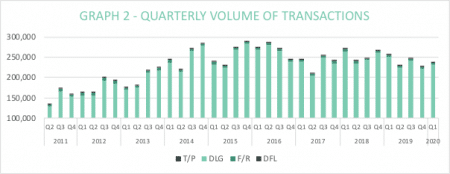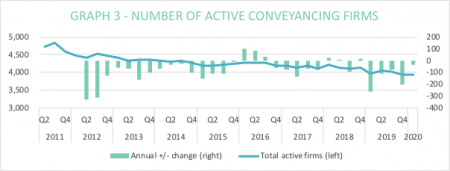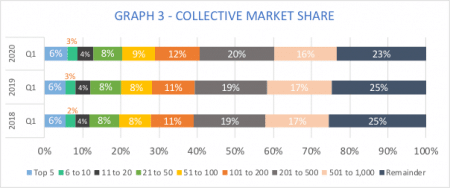 By Legal Futures’ Associates Search Acumen
By Legal Futures’ Associates Search Acumen
The conveyancing market experienced a turbulent ride in Q1 2020 as a post-election bounce in January was swiftly curtailed by the coronavirus pandemic resulting in a steep downturn in March, according to the Q1 2020 edition of the Conveyancing Market Tracker from Search Acumen, the property data insight and technology provider.
The tracker shows that January surpassed 100,000 monthly transactions for the first time in over a year (since November 2018 reached 100,844). January’s total of 104,325 transactions registered across England and Wales was the largest since stamp duty reform four years ago drove 114,425 registrations in April 2016.
This four-year high was swiftly followed by a seven-year low as transactions registered in March dropped to just 55,381 – the lowest monthly total since April 2013 (54,064). The March figure was down 34% year-on-year from March 2019 and down 47% in the space of two months from January.
Overall, the quarter saw a 5% increase in transactions on the previous quarter with 236,641 transactions in Q1 2020, up from 226,444 in Q4 2019. The increase was driven by activity at the start of the year and the brief hope of political and economic certainty returning after December’s election result.
However, this was down 8% year-on-year, with bigger annual falls expected during Q2 as a result of the unprecedented coronavirus lockdown.
Over 400 firms go quiet between January and March
The number of active conveyancing firms remained broadly constant between Q1 2020 and Q4 2019, increasing to 3,928 from 3,920, although this remained lower than the 3,961 who were active a year earlier in Q1 2019.
On closer inspection, the number of active firms reached 4,135 in January 2020, the highest peak since November 2018 (4,168). But as market conditions turned, this measure then fell rapidly to 3,726 in March 2020 – the lowest level since records began in Q2 2011 with over 400 firms going quiet and not registering a single transaction.
Smaller firms are hardest hit
The top 1,000 firms increased their collective market share significantly over the last quarter, registering a new high of 77% in Q1 2020 compared to 71% in Q4 2019. This share was maintained during the onset of lockdown in March, although combined transaction volumes fell significantly to 42,552 compared with 79,610 in January.
At the very top of the conveyancing market, the top five firms maintained the same 6% share in Q1 2020 that they enjoyed in the final quarter of 2019, up from 5.5% a year earlier in Q1 2019. This also remained broadly stable throughout the quarter in the face of adverse market conditions, despite total transaction numbers among the top five dropping 6,353 to 3,310 over the same period.
Conversely, those firms outside the top 1,000 saw their share of the market fall over the last year, from 25% in Q1 2019 to 23% in the first quarter of 2020, having reached 29% at the end of 2019. The total number of transactions they completed also fell 13% year-on-year, from 63,558 to 55,402.
For the average conveyancing firm, transactions improved modestly by 4% from 58 in Q4 2019 to 60 in Q1 2020. However, this was down 7% from 65 at the start of last year. Looking at March 2020, the average firm registered just 15 completed transactions – equivalent to a quarterly run rate of 45, which would be the lowest since Q2 2013.
Andy Sommerville, Director of Search Acumen, comments:
“The first quarter of 2020 was a turbulent ride for conveyancers, along with the rest of the nation. After high hopes for a year of growth came to a dramatic end. The January bounce was followed by a steep drop in transactions and active firms – putting an end to hopes of stability and certainty following the 2019 election. While the seven-week freeze on property transactions that began in March is starting to thaw, it is clear expectations have changed and the property industry cannot simply go back to old ways of working.
“The figures for Q2 will look tougher still, but we have been encouraged by the fresh energy and dedication with which many firms have pivoted their services and sought to digitise traditional practices in the face of adversity. While parts of the industry had been reluctant to adapt for the 21st century, Covid-19 has been an unwelcome catalyst for change that can bring lasting benefits once the health crisis abates. This includes innovations like virtual reality, video viewings and contactless valuations – all bringing greater efficiency to the homebuying process.
“We have long championed the digitisation of the due diligence process and have been focused on helping conveyancers where they can no longer rely on traditional sources of data and information that are crucial to a successful sale or purchase. We have been exploring ways to harness all alternative data sources so conveyancers can give clients early and better-informed insights into potential issues. This will be crucial to avoid a state of ‘lockjam’ as we move into the next phase of social distancing and seek to get the market back on track.
“The importance of embracing digitisation is no longer a question of debate, but it still requires commitment and collaboration across the industry. Government needs to be resolute in its commitment to accessible and accurate data, and work with the private sector to embed an efficient, innovative and productive market – ready to face future crises big or small.”















